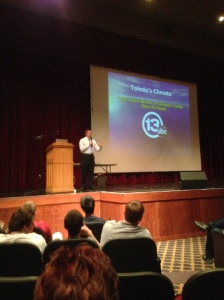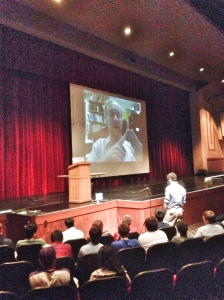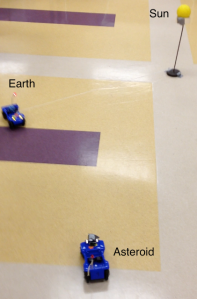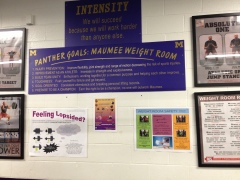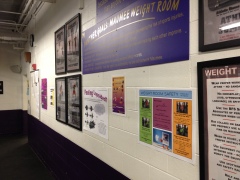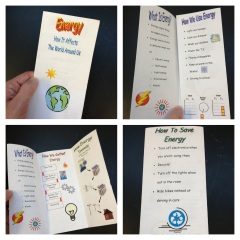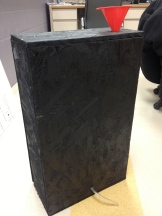I’ve been struggling with this question for years! My first three years of teaching looked very different from each other, even though I’d thought I was prescribing to Modeling Instruction (MI). I’ve realized that simply reading an article (or even this blog post) about Modeling Instruction aren’t enough to paint the entire picture, just like reading about Karate won’t help you fully appreciate it until you’ve tried all of the moves. A fresh explanation might be of some help to people though. So here’s an attempt at answering the title question of this post…
What does Modeling Instruction look like?
 Instead of conventional ‘units’ the course is divided up into the study of different scientific ‘models’. A model is basically a ‘set of rules’ that exists conceptually in our heads that we can use to explain the things we observe. The ‘set of rules’ can be represented with graphs, diagrams, words, equations, charts, etc. The whiteboard at the right was a summary created by students of a model called the ‘Constant Velocity Particle Model’. We used it to explain how certain objects moved.
Instead of conventional ‘units’ the course is divided up into the study of different scientific ‘models’. A model is basically a ‘set of rules’ that exists conceptually in our heads that we can use to explain the things we observe. The ‘set of rules’ can be represented with graphs, diagrams, words, equations, charts, etc. The whiteboard at the right was a summary created by students of a model called the ‘Constant Velocity Particle Model’. We used it to explain how certain objects moved.
Each model takes approximately 2-3 weeks to study. The study of each model includes two phases: development and deployment. The things that typically occur in each phase are outlined below.
Development phase (takes ~2-5 days)
- Students are introduced to a common physical phenomenon (car moving at constant velocity, ball rolling down a ramp, two objects crashing into each other, etc.)
- After noting their observations, they decide which variables they could change that may affect the phenomenon, then choose which they’d like to investigate further by collecting data with available equipment.
- Students work in groups to collect data about the phenomena. If possible, they organize their data with tables, graphs, and equations.
- Students then collaboratively consolidate their data and findings to share with the class. They discuss everyone’s data to come to a consensus on a working model for the phenomena studied.
- At this point, the teacher may introduce terminology and/or representations (force diagrams, energy bar charts, etc.) that can be used to represent the model, such that students are using scientifically consistent language and diagrams to communicate their ideas.
___________________________________________________
Below is a short comic strip I drew up to highlight some important parts of this process. There’s more to the development than this, but this might give you an idea of what I mean.
Deployment phase (takes ~1 week)
- The students then begin using the model to predict how other similar physical situations may unfold. This most often takes place through hypothetical scenarios ( ‘problems’ or ‘questions’) posed by the teacher on a series of worksheets or through an actual practicum, where students must predict how reality will behave.
- In the process, they gain fluency in the use of multiple representations (graphs, diagrams, equations, words) for the model, which solidifies their understanding of the nuances of the model and how it applies to various contexts.
- At different points in this process students may find that they need to refine or change the model (EX. Adding a new energy storage mechanism) to account for a new situation or refine/add a layer to their arsenal of representations (EX. Adding v-t graphs after initial use of x-t graphs, and then defining the area of v-t graph)
How does it all fit together?
MI gives students the opportunity to create and then use what they have created to understand their universe. By doing this over and over again throughout the year, students eventually begin to think and act like real scientists! Each model becomes the backbone for the unit. The teacher and students should always “keep one eye on the model” constantly looking back and forth between the model and reality to understand to what extent they can be superimposed on one another. It is integral that the students understand this process and are engaged in all aspects of it. The teacher facilitates the cycle carefully, armed with content specific knowledge and experience dealing with common student misunderstandings. The teacher never tells the students what to think (if this is even possible), but rather invites them to evaluate their thinking, becoming a sort of metacognitive coach. By doing so, the teacher helps give students the ability and confidence to think for themselves and to experience the thrill of a deep understanding of nature.
The entire curriculum is carefully woven into a coherent storyline, with one model picking up where the last one left off. The failure of a model to explain a new situation motivates the development and deployment of another model. This helps students understand science more clearly as a modeling process, where each model has its limits. Ideally this helps dispel the common idea among students that science is a ‘body of facts’. There aren’t ‘truths’ in science, only tentative models with limitations. How is a student to understand this about science unless they experience it for themselves?
Why does this work so well in promoting lasting conceptual understanding?
While I’m no neuroscientist, I do have a few ideas about why MI is so effective. Throughout the modeling cycle, students are constantly shifting and affirming relationships amongst concepts in their minds. This process of shifting ideas around and adding to them takes careful and frequent thought with powerful representational tools. It also takes time. Both phases of the cycle give students the time and means (via observation, data collection, discussion, representational tools, etc.) they need to process these ideas and integrate them into their belief structure. Throughout the cycle, students are constantly comparing their developed ideas (the model) to reality. In this way, students come to believe in the model (or not, if it doesn’t work) and accept (or deny) it as part of their belief structure about the world. Over time, the new model replaces their former notions about the world, but only if they come to realize that it fits reality better than their old ideas. While it varies from student to student, coming to this realization typically takes most of the time and messiness noted above. Students cannot simply be told what they’re supposed to realize about the world. If science ideas are introduced didactically, most students are left in the dust and miss out on an important opportunity for authentic learning.
What makes modeling stand out from other “inquiry-based” approaches?
While I’m not entirely familiar with all of the flavors of “inquiry” type instruction out there, I do know that there are many different ideas and opinions amongst educators about what “inquiry” instruction is. Often, in talking with others about modeling instruction, I can tell that they tend to attach my words about modeling to their existing ideas about inquiry, and rightfully so. People learn by comparing and contrasting new ideas with what they already think. Unfortunately, this makes it difficult to simply explain what modeling instruction is, since it usually gets lumped together with other inquiry or ‘discovery’ approaches. Often, my descriptions of modeling instruction are interpreted in the context of how single lessons are facilitated. This is part of MI, but is not the entire picture. MI is more so a philosophy behind teaching science than it is a particular way of facilitating lab activities. MI’s focus on the collaborative development and deployment of foundational scientific models is what sets it apart from other inquiry-based lesson-specific teaching techniques. Students “do science” like real scientists, not just during one ‘inquiry-type’ lab, but for nearly all of the course. The design of the curriculum and the modeling cycle promote continuous scientific thinking and doing! Other inquiry based approaches I’ve heard of do not take curriculum design to this level, or emphasize the building and using of models as a primary objective for teaching science. In the modeling curriculum students repeatedly create models and then use them. They don’t discover models. Discovery has more to do with observing something new. Model creation is different. It is the intentional making of a conceptual “set of rules”(represented with graphs, diagrams, words, etc.) to describe or explain what was observed (ie. the ‘discovery’). The heart of Modeling Instruction is all in the name. MI is about making and using scientific models!


